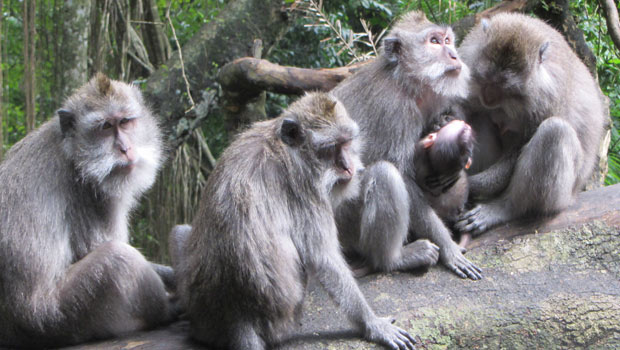Ubud is a major city in south Bali which sees some of Bali’s heaviest tourist traffic, and most of them are there to visit the world-famous Ubud Monkey Forest and sacred monkey temple. This is a truly unique experience, shared by some 10,000 visitors per month.
The monkeys are of the long-tailed Macaque variety, numbering into the hundreds. They typically split up into “troops”, lately about four of them, that take turns roving around and interacting with the visitors. Monkeys are not too territorial but they do have a strong sense of social community, so members of different troops occasionally fight each other. Females stay with the same troop for life; males may migrate from one troop to another.
These monkeys are extremely tame. They’ll come right up and take food out of your hand, and even clamber up on your shoulder. They lounge around on the benches and pathways grooming each other, content in their paradise. If you set your purse down for a minute and turn your back, you’ll turn back to find a few hooligan monkeys raiding your belongings and scampering away with your cosmetics.
A few tips for monkey interaction: Feed them only approved foods provided by the park, which is mostly small bananas; many human foods are unhealthy for monkeys. Some of the more aggressive beggars stay right near the entrance to pounce on you as soon as you enter with a fresh supply.
Remember that monkeys are primates, and they are pretty clever. Underestimate their skills at undoing latches and untying drawstrings and they’ll scamper away with your stuff. The most common monkey-theft items are cameras, jewelry, purses, sunglasses, and water bottles. The park employees will not help you get anything back; indeed, for all we know, there’s a tribe of sunglasses-wearing monkeys deep in the brush calling each other on stolen tourist mobile phones. They especially go for anything shiny.
https://www.youtube.com/watch?v=AxwzlYlhV-g
The best time to go is in the afternoon. Monkeys are more relaxed at this time, since they’ve already had their breakfast from the morning tourists. Monkeys have been known to bite if provoked, but usually don’t do much harm to humans.
Macaque monkeys have a lifespan of around 25 to 30 years. They take about a year to mature from birth. The mothers nurse the young and the entire troop will tend to be protective of the young, so you should take special care not to appear to be threatening baby monkeys. The younger adults tend to be more aggressive. Older adults tend to grow a furry mane, and males even grow a sort of mustache.
There’s also a considerable amount of statuary art in the park, and for some reason visitors often pose for photos of them kissing some statue of a monkey or lizard or Hindu deity of some sort. And if you need refreshment, there’s even a cafe mid-forest called the “Coffee and Copper” where both you and the monkeys can stop by for a bite.
The Monkey Forest is under the ownership and maintenance of Padangtegal, a village that produces and sells arts and crafts. Your fee at the gate helps pay for the upkeep of the forest and supports arts programs in the village. The Monkey Forest is also the subject of international study from the science community, so you might encounter the odd white lab coat there.
You should also keep in mind, upon visiting, that the forest itself is home to hundreds of species of trees and plants, and counts as a conservation area. For this reason, you should take care not to litter or do anything to disturb the environment too much, bearing in mind of course that it’s also the monkey’s home and they’d prefer it stays a healthy environment, too.






